B-hGARP mice
| Strain Name |
C57BL/6-Lrrc32tm1(LRRC32)Bcgen/Bcgen
|
Common Name | B-hGARP mice |
| Background | C57BL/6 | Catalog number | 110102 |
|
Related Genes |
LRRC32 (Leucine-Rich Repeat-Containing Protein 32), GARP (Glycoprotein-A repetitions predominant) | ||
|
NCBI Gene ID |
434215 | ||
mRNA expression analysis
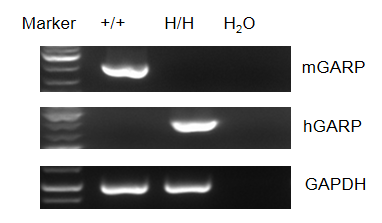
Strain specific analysis of GARP gene expression in WT and B-hGARP mice by RT-PCR. Mouse Garp mRNA was detectable in splenocytes of wild-type (+/+) mice. Human GARP mRNA was detectable only in H/H, but not in +/+ mice.
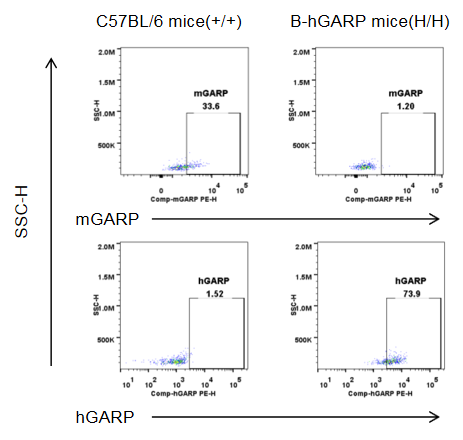
Strain specific GARP expression analysis in wild-type C57BL/6 mice and homozygous B-hGARP mice by flow cytometry. Splenocytes were collected from wild-type and homozygous B-hGARP (H/H) mice, and analyzed by flow cytometry with species-specific GARP antibody. Mouse GARP was detectable in wild-type mice. Human GARP was exclusively detectable in homozygous B-hGARP but not wild-type mice.
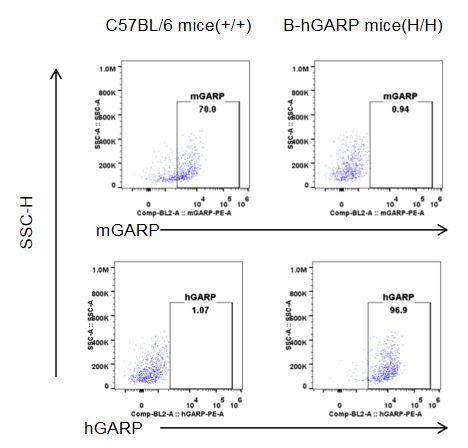
Strain specific GARP expression analysis in wild-type C57BL/6 mice and homozygous B-hGARP mice by flow cytometry. Splenocytes were collected from wild-type C57BL/6 mice and homozygous B-hGARP mice, stimulated with anti-CD3ε (2 μg/mL), anti-CD28(2 μg/mL) in vitro (stimulation for 24 hours). Mouse GARP was exclusively detectable in wild-type mice. Human GARP was exclusively detectable in homozygous B-hGARP mice but not in wild-type mice.
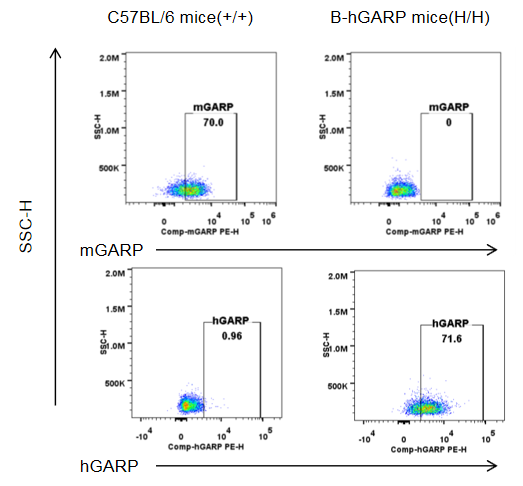
Strain specific GARP expression analysis in homozygous B-hGARP mice by flow cytometry. Blood were isolated from wild-type C57BL/6 mice and homozygous B-hGARP mice, and platelet were gated for mCD41 population and used for further analysis as indicated here. Human GARP was only detectable in homozygous homozygous B-hGARP mice.

Analysis of splenic leukocyte subpopulations by FACS. Splenocytes were isolated from female C57BL/6 and B-hGARP mice (n=3, 6 weeks-old) and analyzed by flow cytometry to assess leukocyte subpopulations. (A) Representative FACS plots gated on single live CD45+ cells for further analysis. (B) Results of FACS analysis. Percentages of T, B, NK cells, monocyte/macrophages, and DC were similar in homozygous B-hGARP mice and C57BL/6 mice, demonstrating that introduction of hGARP in place of its mouse counterpart does not change the overall development, differentiation, or distribution of these cell types in spleen. Values are expressed as mean ± SEM.
Analysis of spleen leukocyte subpopulations in B-hGARP mice
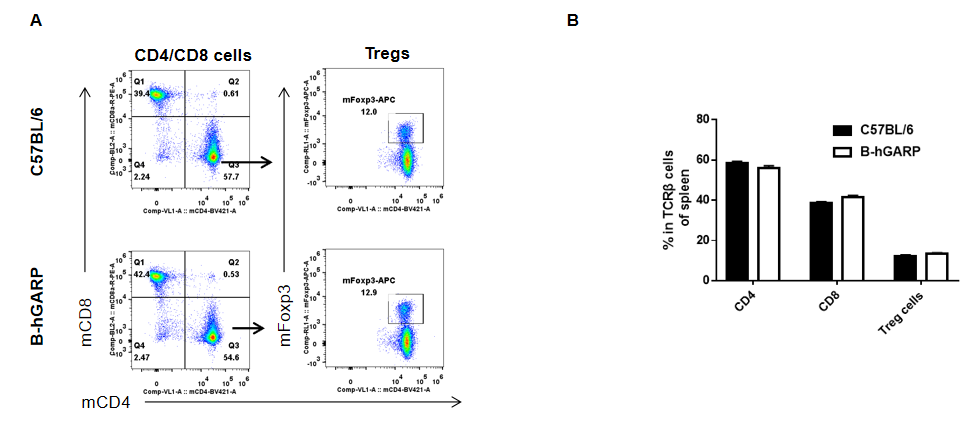
Analysis of splenic T cell subpopulations by FACS. Splenocytes were isolated from female C57BL/6 and B-hGARP mice (n=3, 6 weeks-old) and analyzed by flow cytometry for T cell subsets. (A) Representative FACS plots gated on CD3+ T cells and further analyzed. (B) Results of FACS analysis. Percentages of CD8+, CD4+, and Treg cells were similar in homozygous B-hGARP and C57BL/6 mice, demonstrating that introduction of hGARP in place of its mouse counterpart does not change the overall development, differentiation or distribution of these T cell subtypes in spleen. Values are expressed as mean ± SEM.
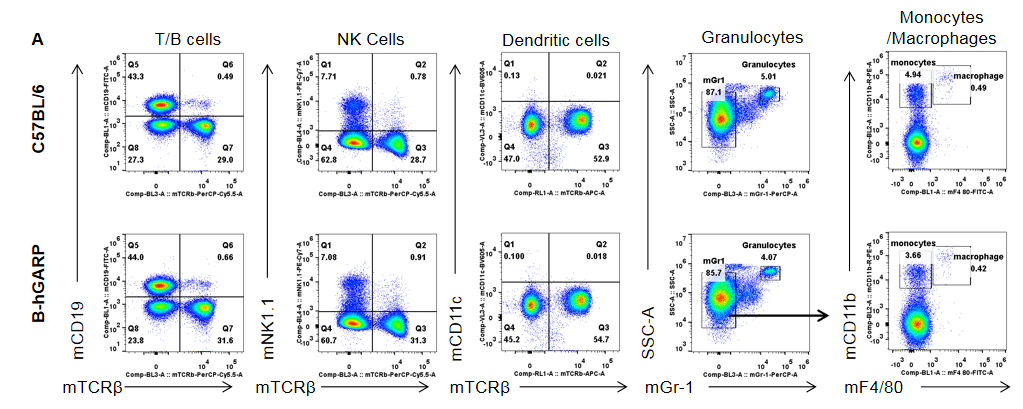
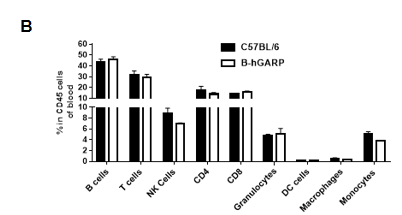
Analysis of blood leukocyte subpopulations by FACS. Blood were isolated from female C57BL/6 and B-hGARP mice (n=3, 6 weeks-old) and analyzed by flow cytometry to assess leukocyte subpopulations. (A) Representative FACS plots gated on single live CD45+ cells for further analysis. (B) Results of FACS analysis. Percentages of T, B, NK cells, monocyte/macrophages, and DC were similar in homozygous B-hGARP mice and C57BL/6 mice, demonstrating that introduction of hGARP in place of its mouse counterpart does not change the overall development, differentiation, or distribution of these cell types in blood. Values are expressed as mean ± SEM.
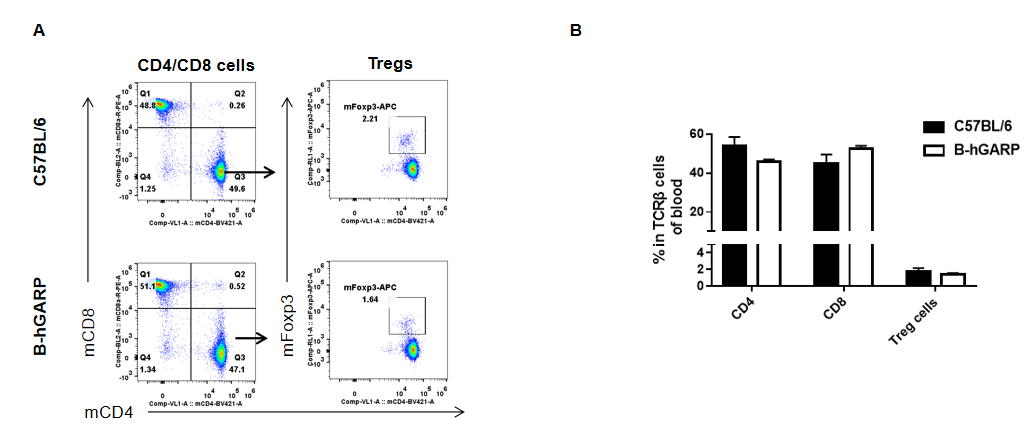
Analysis of blood T cell subpopulations by FACS.Blood were isolated from female C57BL/6 and B-hGARP mice (n=3, 6 weeks-old) and analyzed by flow cytometry for T cell subsets. (A) Representative FACS plots gated on CD3+ T cells and further analyzed. (B) Results of FACS analysis. Percentages of CD8+, CD4+, and Treg cells were similar in homozygous B-hGARP and C57BL/6 mice, demonstrating that introduction of hGARP in place of its mouse counterpart does not change the overall development, differentiation or distribution of these T cell subtypes in blood. Values are expressed as mean ± SEM.
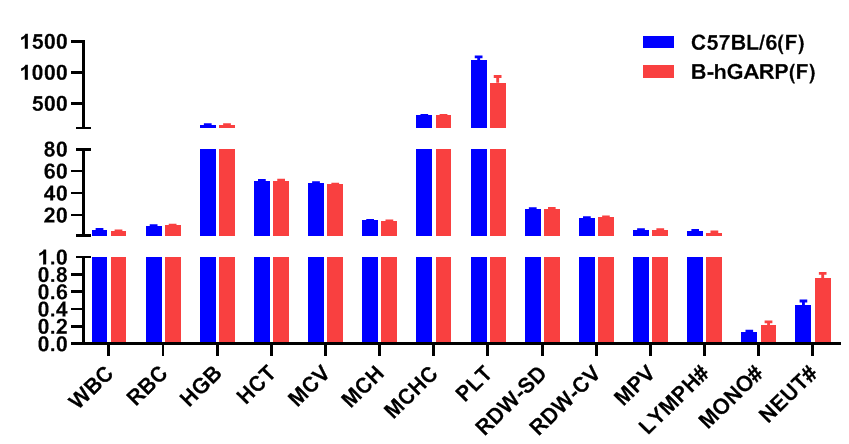
Blood routine tests of B-hGARP mice. Blood from female C57BL/6 and B-hGARP mice (n=6, 6 week-old, female) were collected and analyzed for CBC. Any measurement of B-hGARP mice in the panel were similar to C57BL/6, indicating that humanized mouse does not change blood cell composition and morphology. Values are expressed as mean ± SEM.
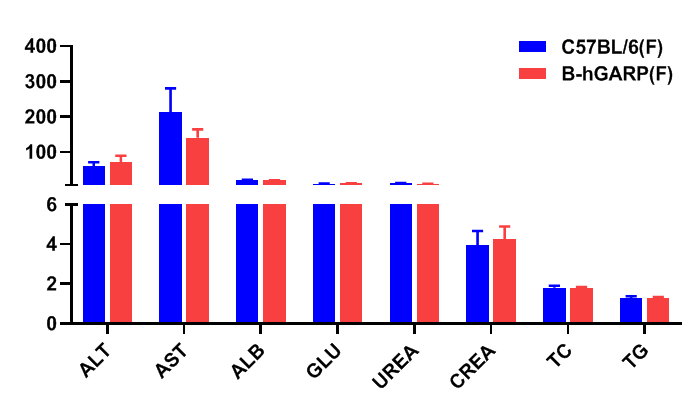
Blood chemistry tests of B-hGARP mice. Serum from C57BL/6 and B-hGARP mice (n=6, 6 week-old, female) were collected and analyzed for levels of ALT, AST and other indicators in the panel. There was no differences on either measurement between C57BL/6 and humanized mouse, indicating that humanized mouse does not change ALT and AST levels or health of liver. Values are expressed as mean ± SEM.
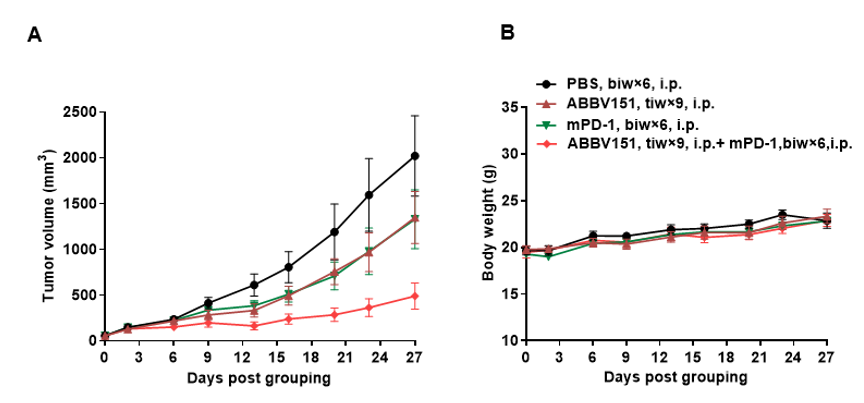
Antitumor activity of anti-mouse PD-1 antibody combined with anti-human GARP/latent-TGFβ1 antibody in B-hGARP mice. (A) Anti-mouse PD-1 antibody combined with anti-human GARP/latent-TGFβ1 antibody (in house) inhibited MC38 tumor growth in B-hGARP mice. Murine colon cancer MC38 cells (5E5) were subcutaneously implanted into homozygous B-hGARP mice (female, 7-week-old, n=6). Mice were grouped when tumor volume reached approximately 50~70 mm3, at which time they were treated with anti-mouse PD-1 antibody and anti-human GARP/latent-TGFβ1 antibody with doses and schedules indicated in panel A. (B) Body weight changes during treatment. As shown in panel A, combination of anti-mPD-1 antibody and anti-human GARP/latent-TGFβ1 antibody were efficacious in controlling tumor growth in B-hGARP, demonstrating that the B-hGARP mice provide a powerful preclinical model for in vivo evaluation of anti-human GARP antibodies. Values are expressed as mean ± SEM.












 京公网安备:
京公网安备: